Safety Evaluation of Crossing Tunnel Engineering: A Case Study
Abstract
:1. Introduction
2. Geological Conditions
2.1. Geological Conditions of the Existing Highway Tunnel
2.2. Geological Conditions of the Newly Excavated Railway Tunnel
2.3. Intersection Situation of Tunnels
3. Analysis of Highway Tunnel Safety
3.1. Judgment of Vertical Alignment Intersection Closeness in Tunnels
3.2. Establishment of Numerical Calculation Model
- (1)
- Geometric model and calculation assumptions: The geometric model of the tunnels is defined, and necessary assumptions are made to facilitate the numerical calculations.
- (2)
- Calculation parameters and boundary condition settings: The required calculation parameters and boundary conditions are determined and defined for the numerical simulation.
- (3)
- Construction process simulation and implementation: The construction process of the tunnels is simulated using the numerical model, and the calculations are implemented to analyze the behavior and response of the tunnels during construction.
3.2.1. Geometric Model and Calculation Assumptions
3.2.2. Calculate Parameters and Boundary Conditions Setting
3.2.3. Construction Process Simulation and Realization
- (1)
- Initial balance, activate stratum, apply displacement boundary condition and gravity, tick displacement zero, and carry on initial balance;
- (2)
- Simulate the process of highway tunnel construction, simulate the cycle of excavation-initial support-second lining until the completion of highway tunnel construction;
- (3)
- Simulate the influence of railway tunnel excavation on highway tunnel, and simulate the cycle of excavation-initial support-second lining until the railway construction is completed;
- (4)
- Simulate the influence of blasting on highway tunnel, (3) conduct dynamic analysis based on the stress field obtained with static calculation; when construction reaches the crossing point of railway tunnel and highway tunnel, apply the equivalent blasting load at the crossing point. When the boundary conditions around the model are changed to viscous non-reflection boundary, use nonlinear time history analysis.
3.3. Static Response Analysis
3.3.1. Analysis of Highway Tunnel Excavation
3.3.2. Horizontal Displacement Analysis of Highway Tunnel
3.3.3. Vertical Displacement Analysis of Highway Tunnel
3.4. Dynamic Response Analysis
3.4.1. Parameter Selection
3.4.2. Vibration Speed Analysis
4. Conclusions
- (1)
- Analysis of the vertical alignment intersection closeness in tunnels shows that the new railway tunnel has an effect on the existing highway tunnel structure, but the effect is weak, and it usually does not cause harm;
- (2)
- The horizontal displacement is the smallest at the invert and vault of the highway tunnel, slightly larger at the left and right arch feet, and the largest at the left and right side walls. The horizontal displacement of the highway tunnel initially remains relatively constant with distance from the front face of the railway tunnel, then increases rapidly, and finally converges without further increase. The maximum horizontal displacement caused by the railway tunnel construction is 0.540 mm and −0.59 mm;
- (3)
- The vertical displacement is the largest at the arch top and the smallest at the invert of the highway tunnel. Similar to the horizontal displacement, the vertical displacement of the highway tunnel also shows an increasing trend with the distance from the face of the railway tunnel. The maximum vertical displacement caused by railway tunnel construction is 1.42 mm;
- (4)
- The vibration velocity is highest at the vault of the highway tunnel and increases initially before decreasing with time, reaching a peak value of 1.527 cm/s at 16 ms. Throughout the entire process of blasting construction, the vibration velocity of the highway tunnel remains below 2 cm/s. The results demonstrate that the excavation process for the railway tunnel in this study is safe and manageable for the adjacent highway tunnel.
Author Contributions
Funding
Institutional Review Board Statement
Informed Consent Statement
Data Availability Statement
Conflicts of Interest
References
- Liang, Q.; Li, J.; Li, D.; Ou, E. Effect of blast-induced vibration from new railway tunnel on existing adjacent railway tunnel in Xinjiang, China. Rock Mech. Rock Eng. 2013, 46, 19–39. [Google Scholar] [CrossRef]
- Lou, P.; Huang, W.; Huang, X. Analysis of Shield Tunnels Undercrossing an Existing Building and Tunnel Reinforcement Measures. Appl. Sci. 2023, 13, 5729. [Google Scholar] [CrossRef]
- Liu, R.; Yang, J.; Du, Y.; Li, M. Influence of Blasting Disturbance on the Dynamic Stress Distribution and Fracture Area of Rock Tunnels. Appl. Sci. 2023, 13, 5503. [Google Scholar] [CrossRef]
- Xue, F.; Xia, C.; Li, G.; Jin, B.; He, Y.; Fu, Y. Safety threshold determination for blasting vibration of the lining in existing tunnels under adjacent tunnel blasting. Adv. Civ. Eng. 2019, 2019, 8303420. [Google Scholar] [CrossRef]
- Fan, H.; Qiu, J.; Xie, Y. Blast-induced ground vibration from tunnel undercrossing a village. J. PLA Univ. Sci. Technol. (Nat. Sci. Ed.) 2016, 17, 209–214. [Google Scholar]
- Wang, M.-N.; Pan, X.-M.; Zhang, C.-M. Study of blasting vibration influence on close-spaced tunnel. Rock Soil Mech. -Wuhan 2004, 25, 412–414. [Google Scholar]
- Bian, K.; Liu, D.; Jia, J. Investigation and analysis of effect of engineering blasting on railway tunnel failure. In Colloquium on Engineering Blasting; Metallurgical Industry Press: Beijing, China, 1988; pp. 199–205. [Google Scholar]
- Shreyas, S.; Dey, A. Application of soft computing techniques in tunnelling and underground excavations: State of the art and future prospects. Innov. Infrastruct. Solut. 2019, 4, 46. [Google Scholar] [CrossRef]
- Yan, T.; Shen, S.-L.; Zhou, A.; Lyu, H.-M. Construction efficiency of shield tunnelling through soft deposit in Tianjin, China. Tunn. Undergr. Space Technol. 2021, 112, 103917. [Google Scholar] [CrossRef]
- Elbaz, K.; Shen, S.-L.; Zhou, A.; Yin, Z.-Y.; Lyu, H.-M. Prediction of disc cutter life during shield tunneling with AI via the incorporation of a genetic algorithm into a GMDH-type neural network. Engineering 2021, 7, 238–251. [Google Scholar] [CrossRef]
- Liu, Z.; Jiang, N.; Sun, J.; Xia, Y.; Lyu, G. Influence of tunnel blasting construction on adjacent highway tunnel: A case study in Wuhan, China. Int. J. Prot. Struct. 2020, 11, 283–303. [Google Scholar] [CrossRef]
- Sapigni, M.; La Barbera, G.; Ghirotti, M. Engineering geological characterization and comparison of predicted and measured deformations of a cavern in the Italian Alps. Eng. Geol. 2003, 69, 47–62. [Google Scholar] [CrossRef]
- Yoshida, T.; Ohnishi, Y.; Nishiyama, S.; Hirakawa, Y.; Mori, S. Behavior of discontinuties during excavation of two large underground caverns. Int. J. Rock Mech. Min. Sci. 2004, 41, 864–869. [Google Scholar] [CrossRef]
- Fekete, S.; Diederichs, M.; Lato, M. Geotechnical and operational applications for 3-dimensional laser scanning in drill and blast tunnels. Tunn. Undergr. Space Technol. 2010, 25, 614–628. [Google Scholar] [CrossRef]
- Ter-Martirosyan, A.Z.; Cherkesov, R.H.; Isaev, I.O.; Shishkina, V.V. Surface Settlement during Tunneling: Field Observation Analysis. Appl. Sci. 2022, 12, 9963. [Google Scholar] [CrossRef]
- Zhu, W.; Zhang, Q.; Zhu, H.-H.; Li, Y.; Yin, J.-H.; Li, S.; Sun, L.; Zhang, L. Large-scale geomechanical model testing of an underground cavern group in a true three-dimensional (3-D) stress state. Can. Geotech. J. 2010, 47, 935–946. [Google Scholar] [CrossRef]
- Huang, F.; Zhu, H.; Xu, Q.; Cai, Y.; Zhuang, X. The effect of weak interlayer on the failure pattern of rock mass around tunnel–Scaled model tests and numerical analysis. Tunn. Undergr. Space Technol. 2013, 35, 207–218. [Google Scholar] [CrossRef]
- Kiani, M.; Akhlaghi, T.; Ghalandarzadeh, A. Experimental modeling of segmental shallow tunnels in alluvial affected by normal faults. Tunn. Undergr. Space Technol. 2016, 51, 108–119. [Google Scholar] [CrossRef]
- Lei, M.; Peng, L.; Shi, C. Model test to investigate the failure mechanisms and lining stress characteristics of shallow buried tunnels under unsymmetrical loading. Tunn. Undergr. Space Technol. 2015, 46, 64–75. [Google Scholar] [CrossRef]
- Feng, L.; Zhang, L. Assessment of tunnel face stability subjected to an adjacent tunnel. Reliab. Eng. Syst. Saf. 2021, 205, 107228. [Google Scholar] [CrossRef]
- Dong, Y.; Zhang, H.; Zhu, Z.; Zhu, Y. Numerical Simulation Method for Tunnel Excavation Considering Mechanical Characteristic Variation of Soft Rock with the Confining Pressure Influence. Appl. Sci. 2023, 13, 7305. [Google Scholar] [CrossRef]
- Zhang, J.; Shi, K.; Majiti, H.; Shan, H.; Fu, T.; Shi, R.; Lu, Z. Study on the Classification and Identification Methods of Surrounding Rock Excavatability Based on the Rock-Breaking Performance of Tunnel Boring Machines. Appl. Sci. 2023, 13, 7060. [Google Scholar] [CrossRef]
- Peng, K.; Yi, G.; Luo, S.; Si, X. Stress Analysis and Spalling Failure Simulation on Surrounding Rock of Deep Arch Tunnel. Appl. Sci. 2023, 13, 6474. [Google Scholar] [CrossRef]
- Choi, Y.-H.; Lee, S.S. Reliability and efficiency of metamodel for numerical back analysis of tunnel excavation. Appl. Sci. 2022, 12, 6851. [Google Scholar] [CrossRef]
- Yertutanol, K.; Akgün, H.; Sopacı, E. Displacement monitoring, displacement verification and stability assessment of the critical sections of the Konak tunnel, İzmir, Turkey. Tunn. Undergr. Space Technol. 2020, 101, 103357. [Google Scholar] [CrossRef]
- Asker, K.; Fouad, M.T.; Bahr, M.; El-Attar, A. Numerical analysis of reducing tunneling effect on viaduct piles foundation by jet grouted wall. Min. Miner. Depos. 2021, 15, 75–86. [Google Scholar] [CrossRef]
- Zhang, K.; Lyu, H.-M.; Shen, S.-L.; Zhou, A.; Yin, Z.-Y. Evolutionary hybrid neural network approach to predict shield tunneling-induced ground settlements. Tunn. Undergr. Space Technol. 2020, 106, 103594. [Google Scholar] [CrossRef]
- Ahangari, K.; Moeinossadat, S.R.; Behnia, D. Estimation of tunnelling-induced settlement by modern intelligent methods. Soils Found. 2015, 55, 737–748. [Google Scholar] [CrossRef]
- Lyu, H.-M.; Shen, S.-L.; Zhou, A.; Yin, Z.-Y. Assessment of safety status of shield tunnelling using operational parameters with enhanced SPA. Tunn. Undergr. Space Technol. 2022, 123, 104428. [Google Scholar] [CrossRef]
- Bouayad, D.; Emeriault, F. Modeling the relationship between ground surface settlements induced by shield tunneling and the operational and geological parameters based on the hybrid PCA/ANFIS method. Tunn. Undergr. Space Technol. 2017, 68, 142–152. [Google Scholar] [CrossRef]
- Armaghani, D.J.; Mohamad, E.T.; Narayanasamy, M.S.; Narita, N.; Yagiz, S. Development of hybrid intelligent models for predicting TBM penetration rate in hard rock condition. Tunn. Undergr. Space Technol. 2017, 63, 29–43. [Google Scholar] [CrossRef]
- Ashrafi, S.B.; Anemangely, M.; Sabah, M.; Ameri, M.J. Application of hybrid artificial neural networks for predicting rate of penetration (ROP): A case study from Marun oil field. J. Pet. Sci. Eng. 2019, 175, 604–623. [Google Scholar] [CrossRef]
- Kohestani, V.; Bazarganlari, M.; Asgari Marnani, J. Prediction of maximum surface settlement caused by earth pressure balance shield tunneling using random forest. J. AI Data Min. 2017, 5, 127–135. [Google Scholar]
- Lyu, H.-M.; Sun, W.-J.; Shen, S.-L.; Zhou, A.-N. Risk assessment using a new consulting process in fuzzy AHP. J. Constr. Eng. Manag. 2020, 146, 04019112. [Google Scholar] [CrossRef]
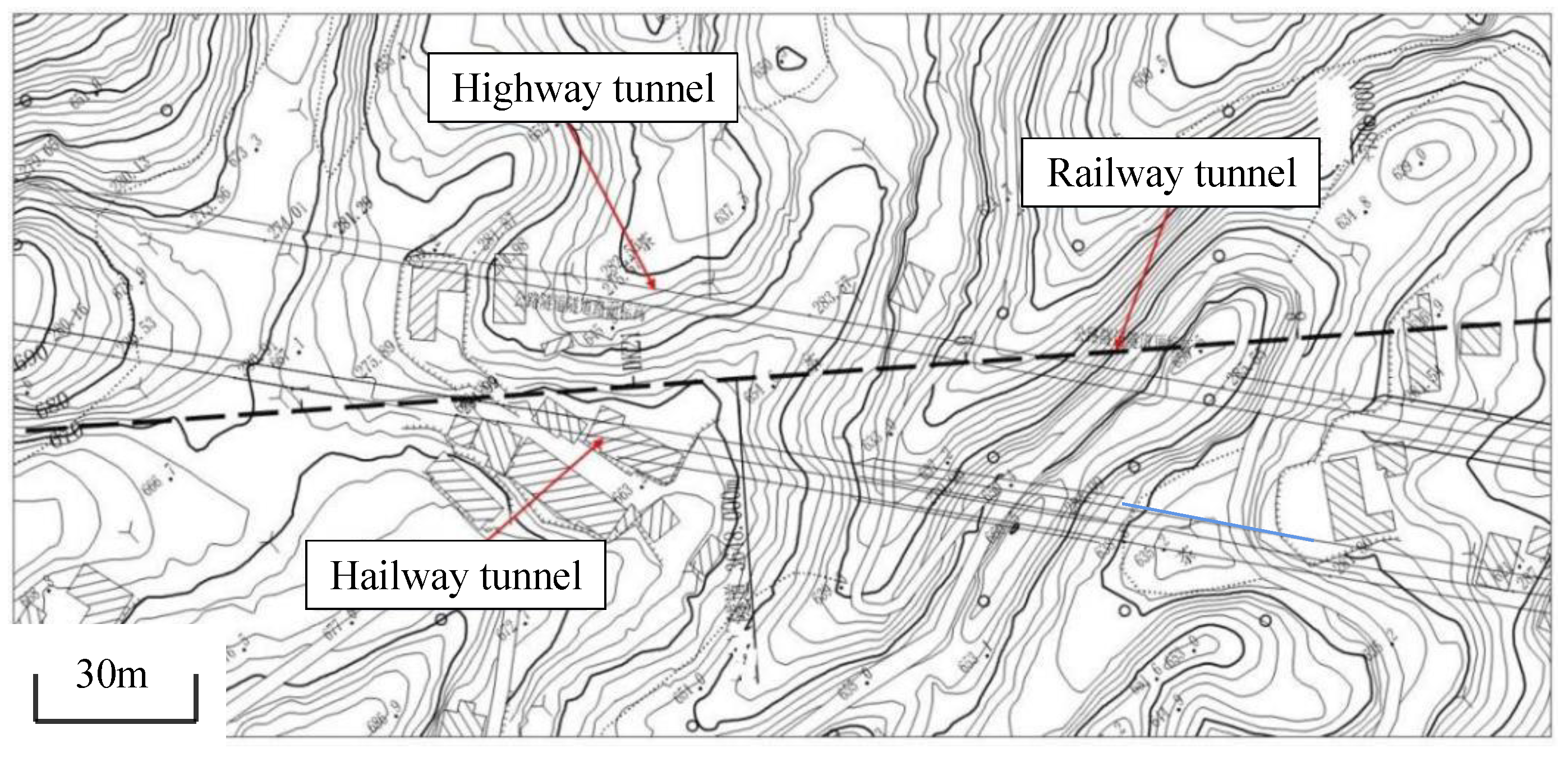
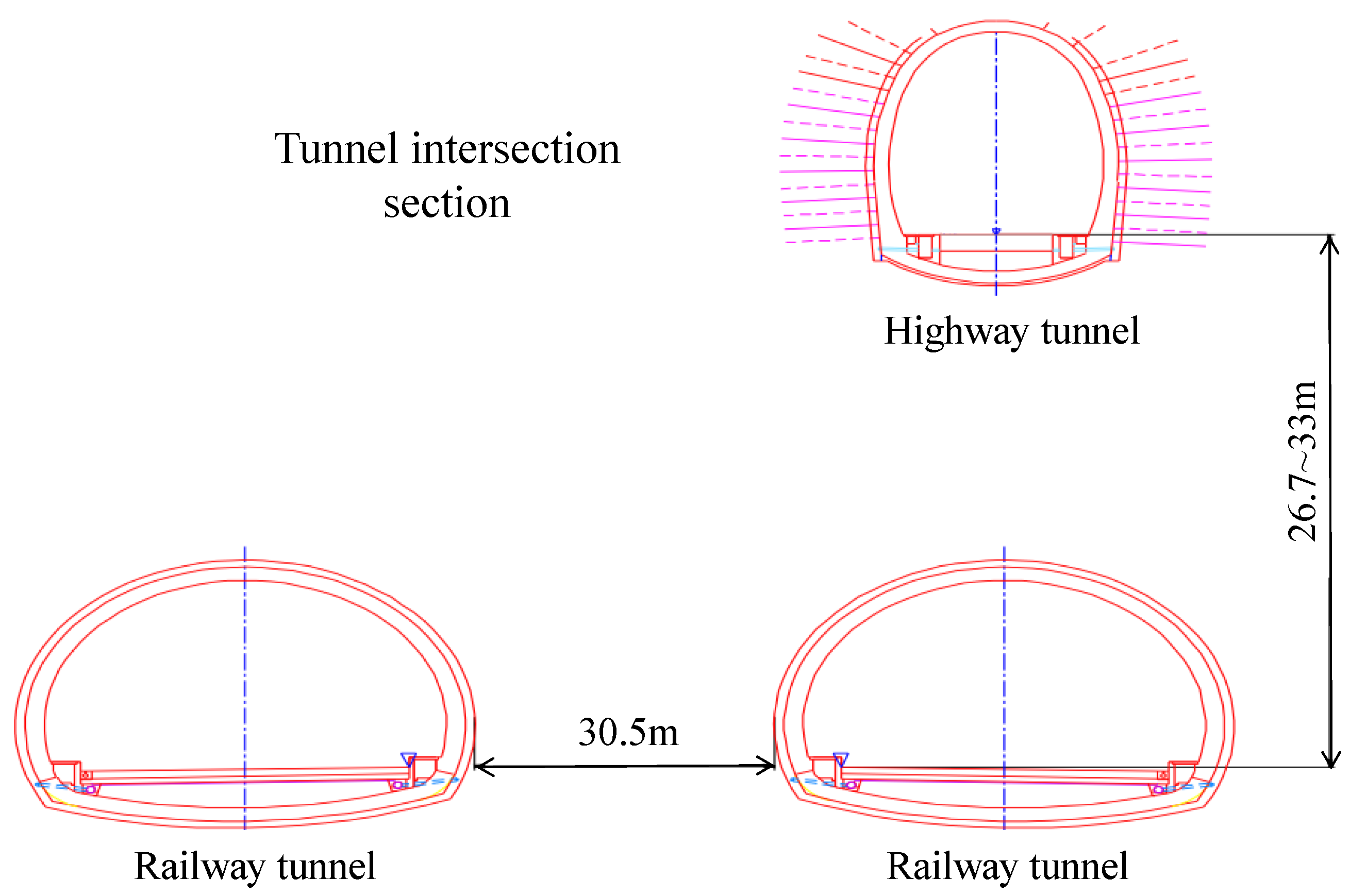
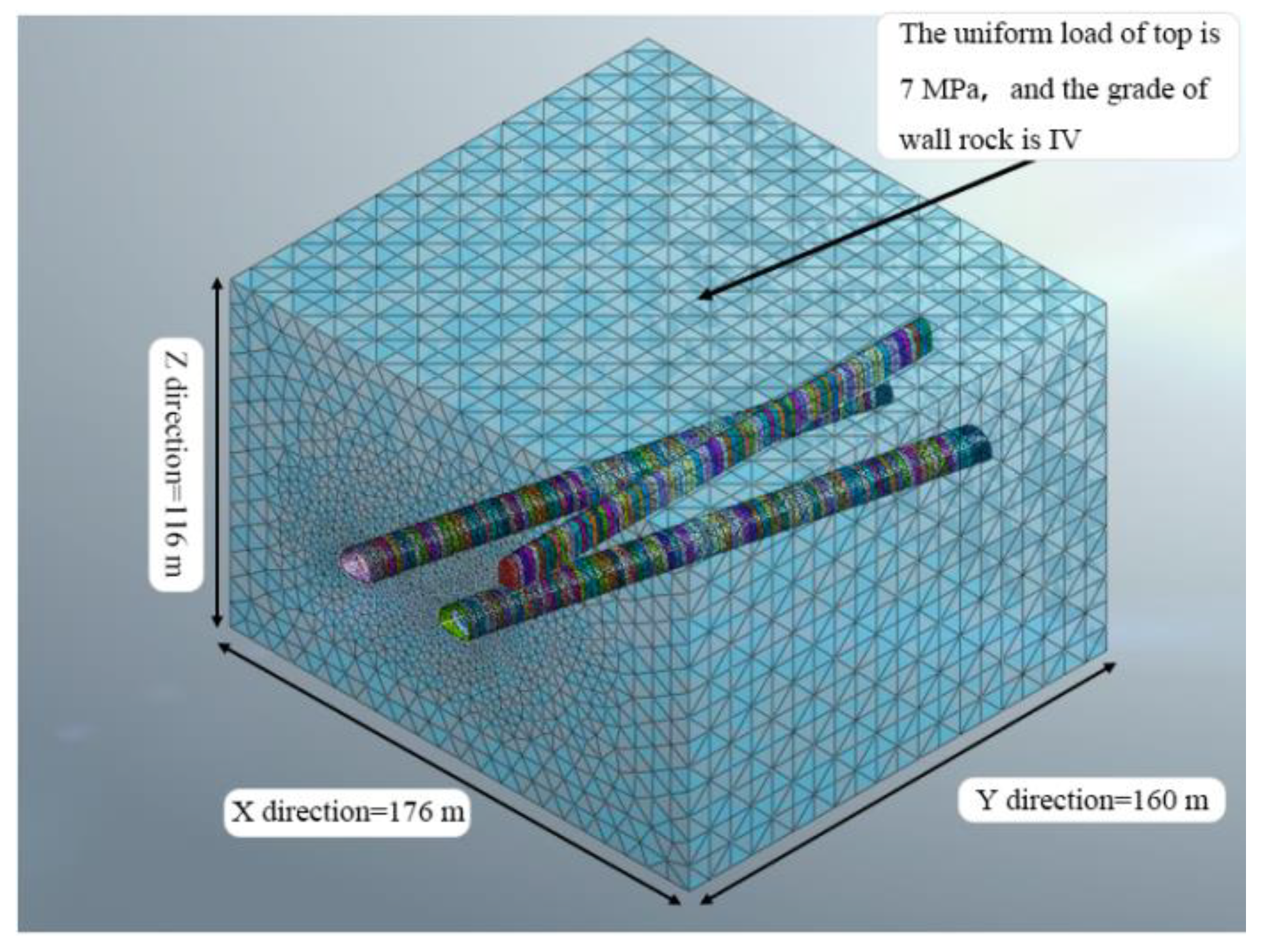
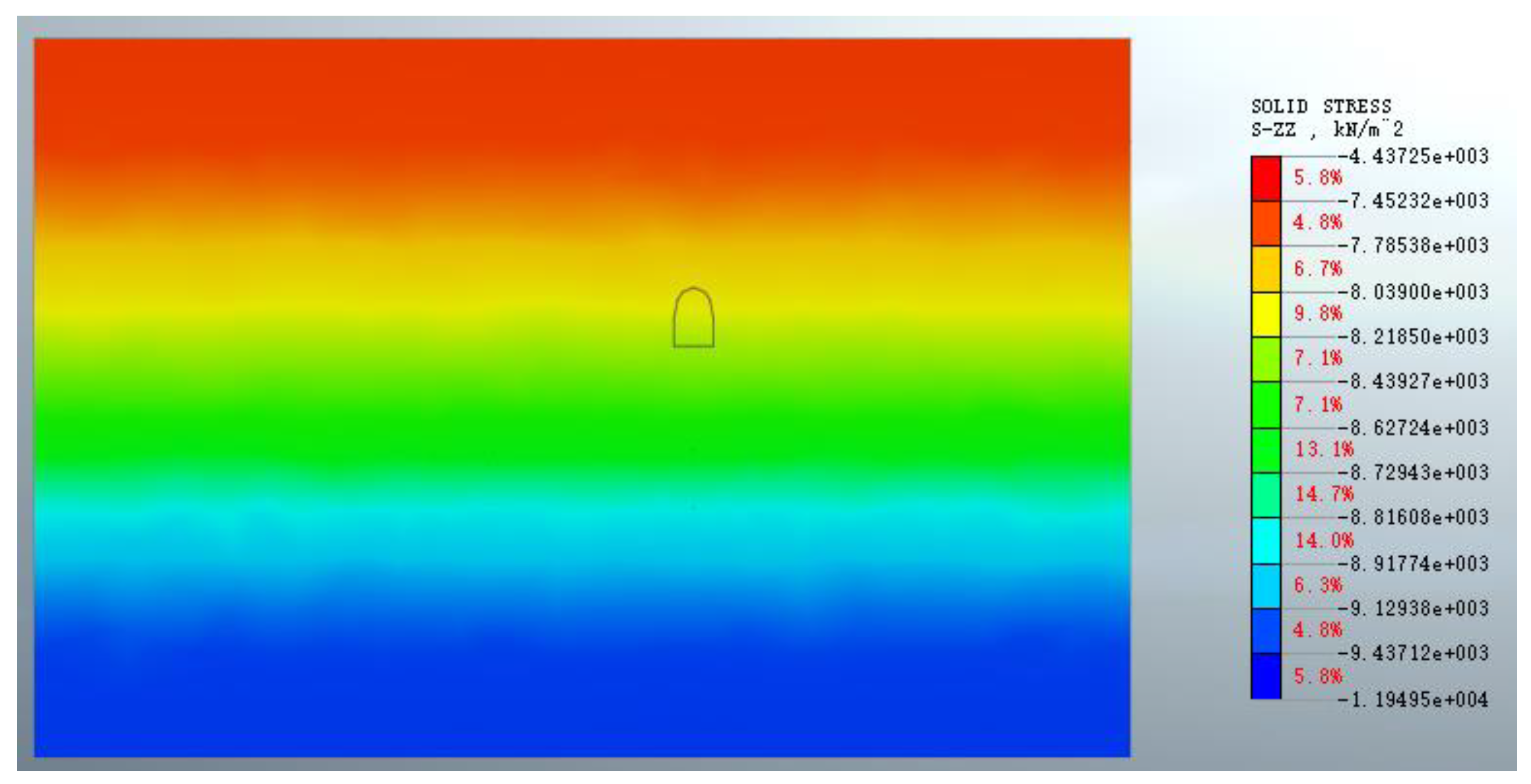

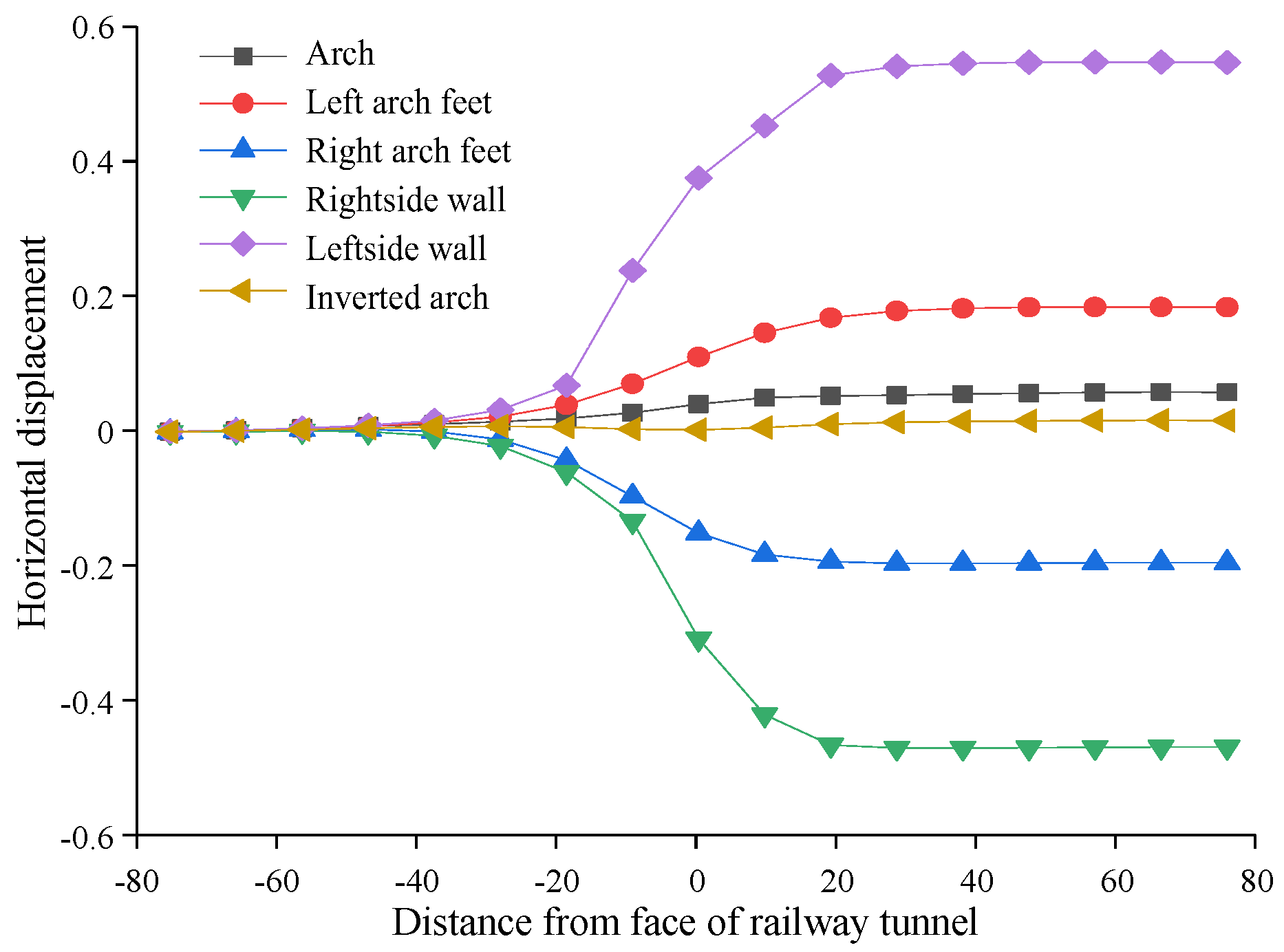
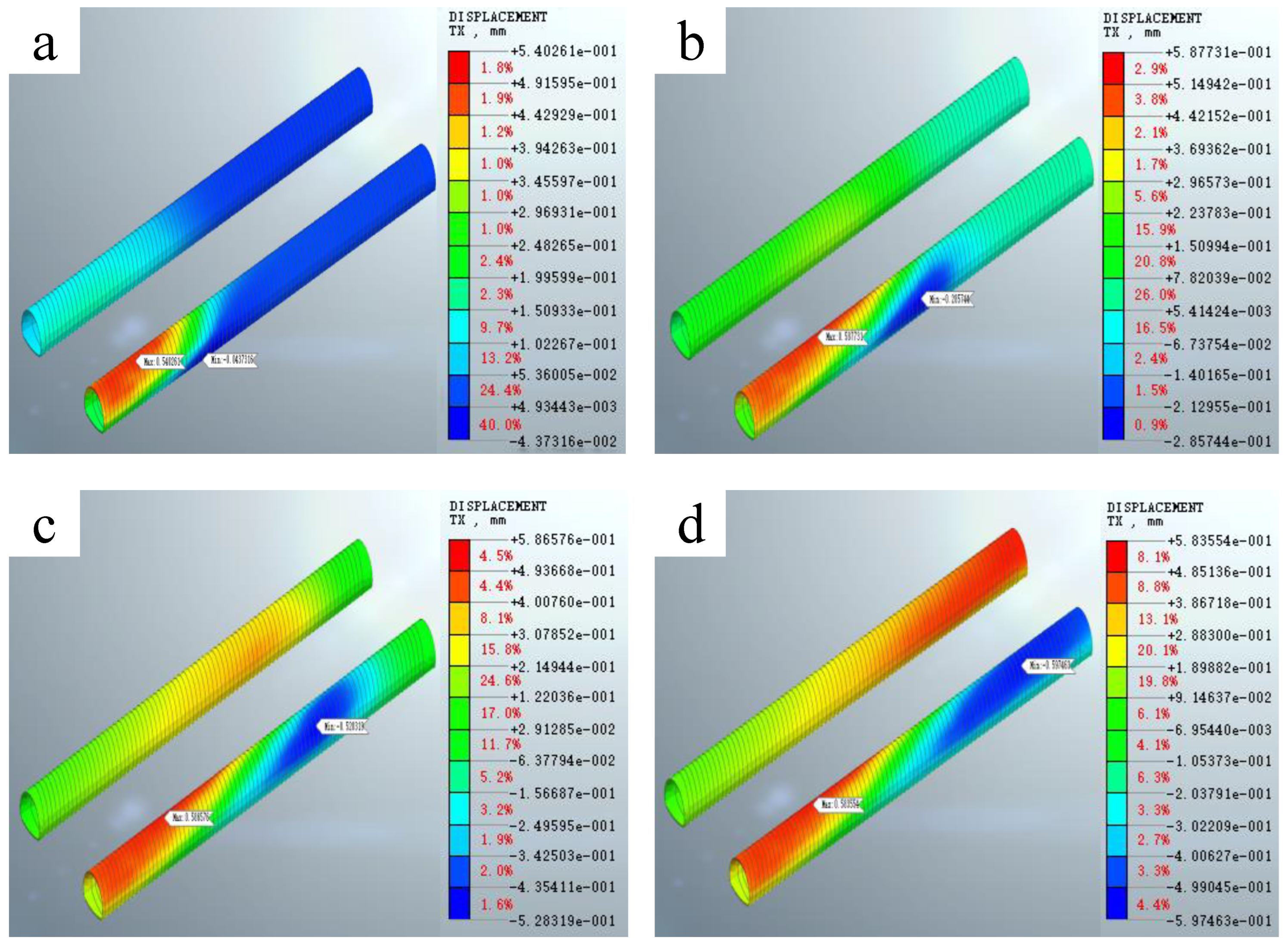
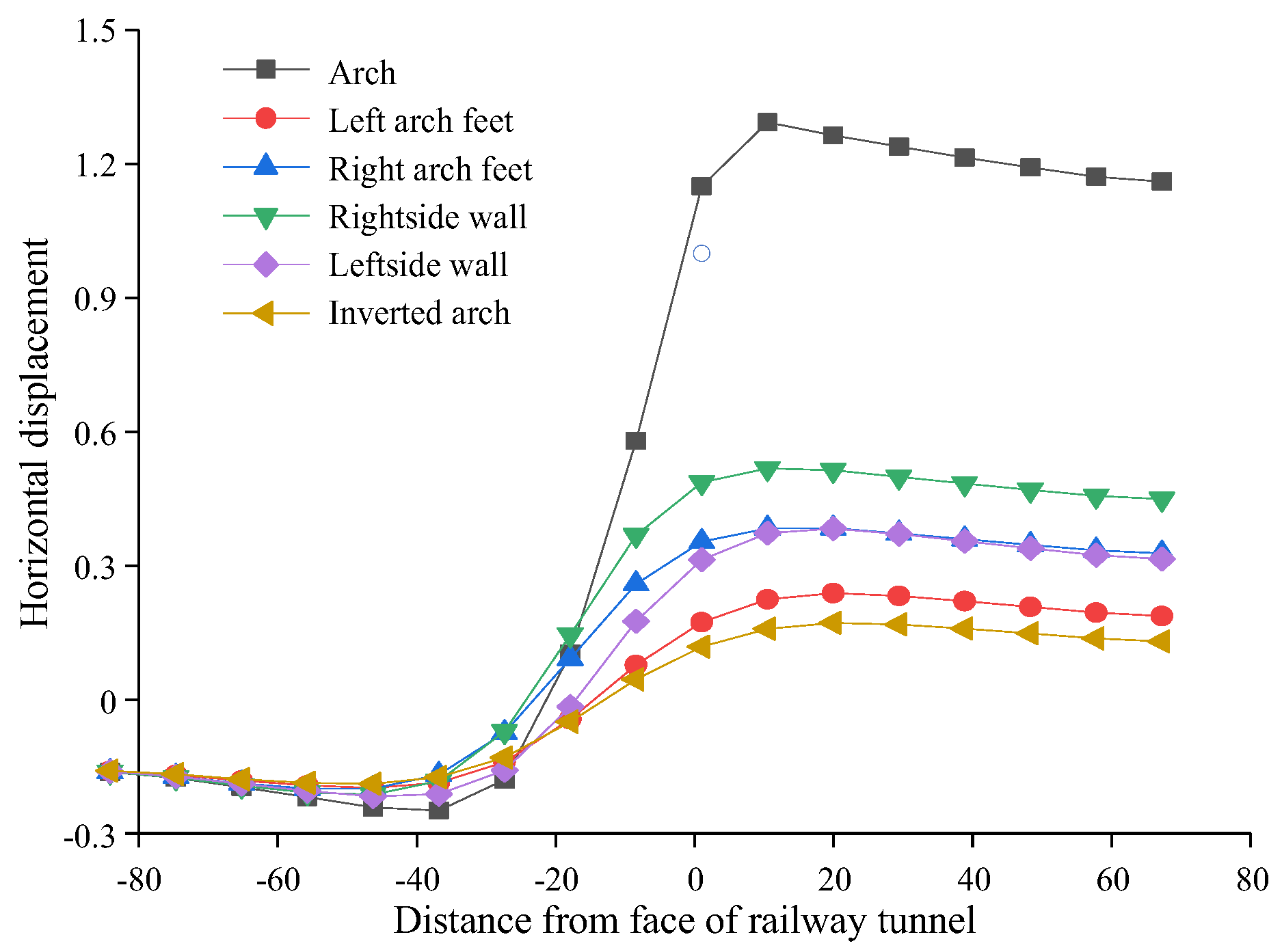
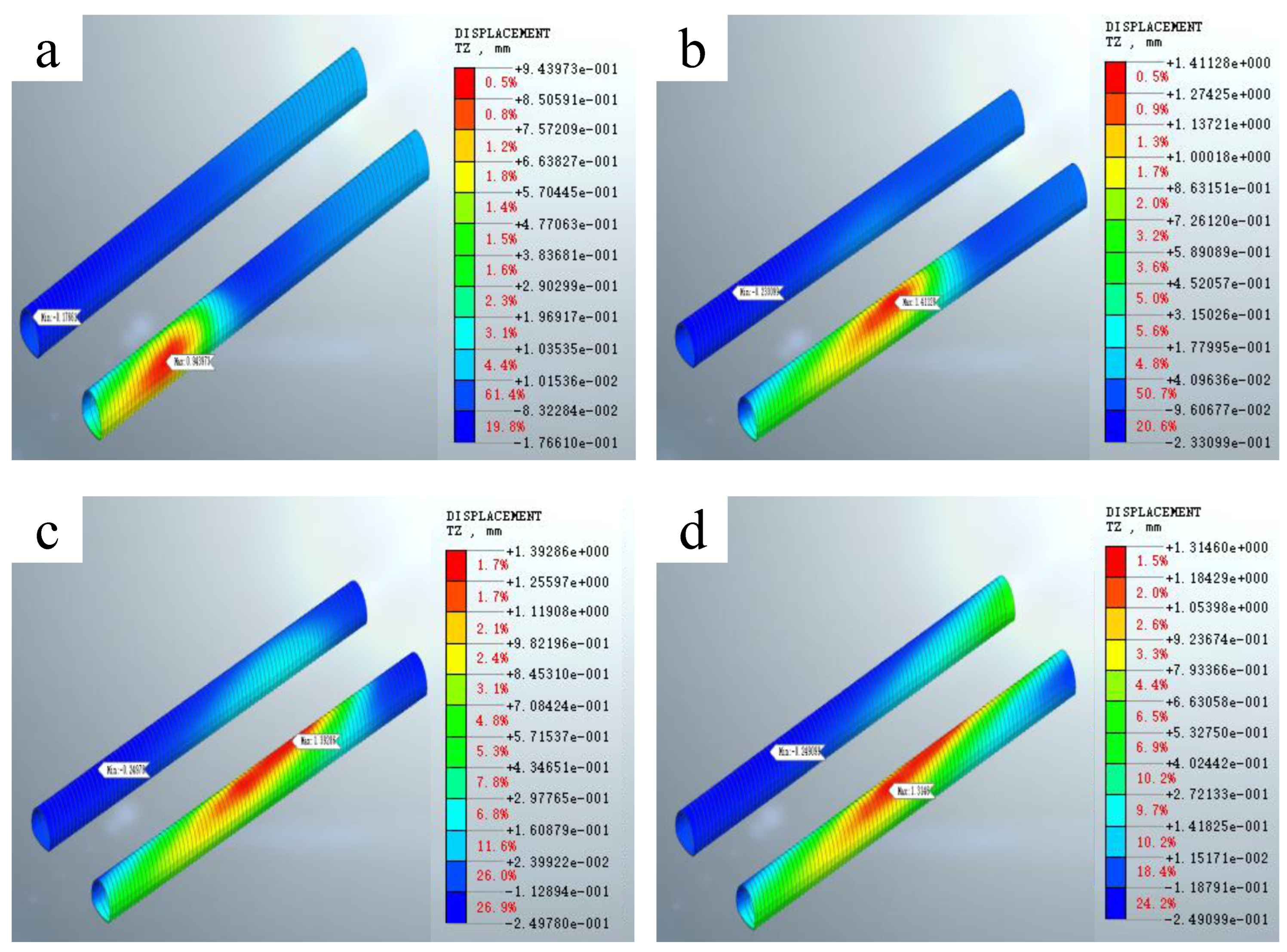
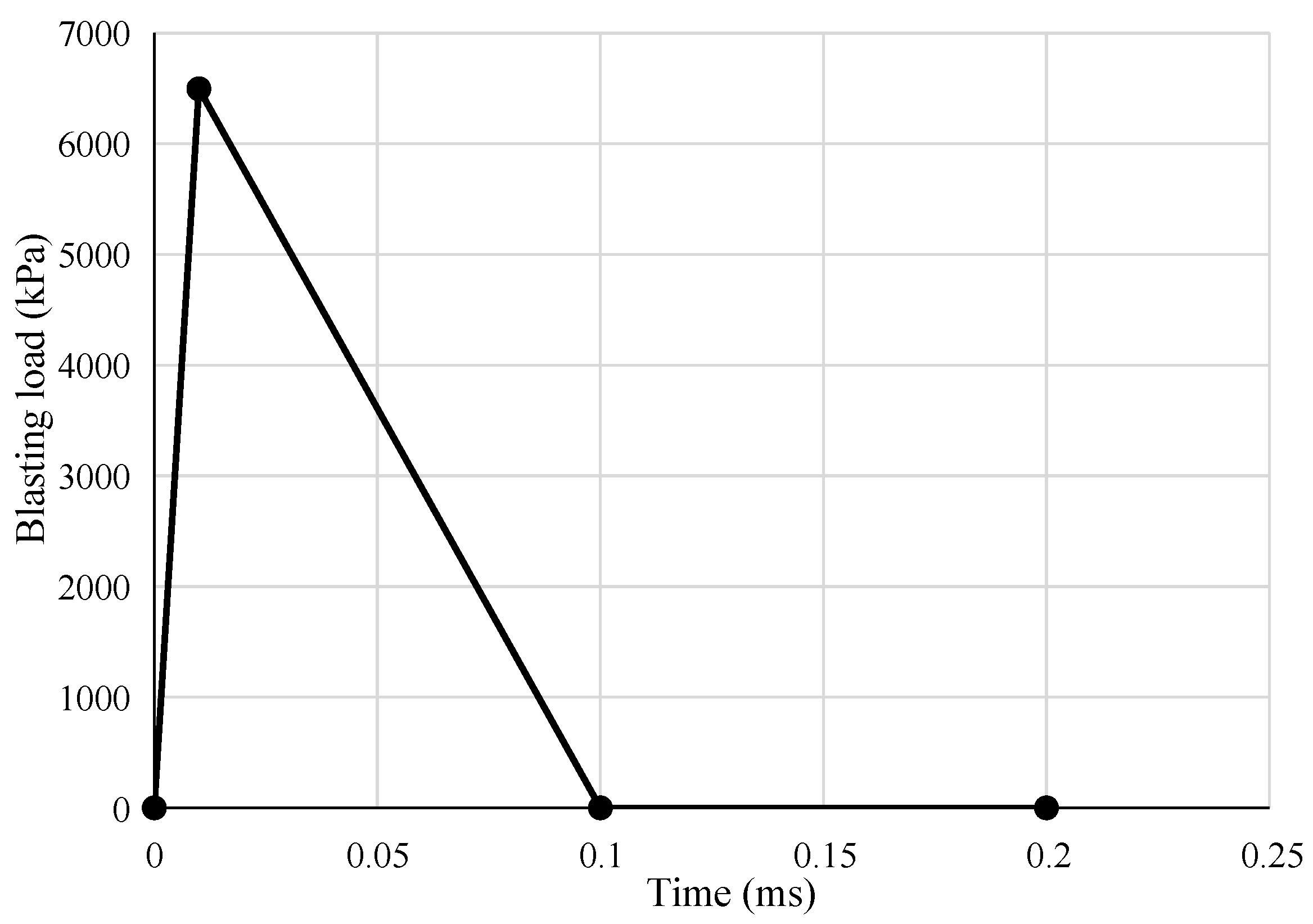
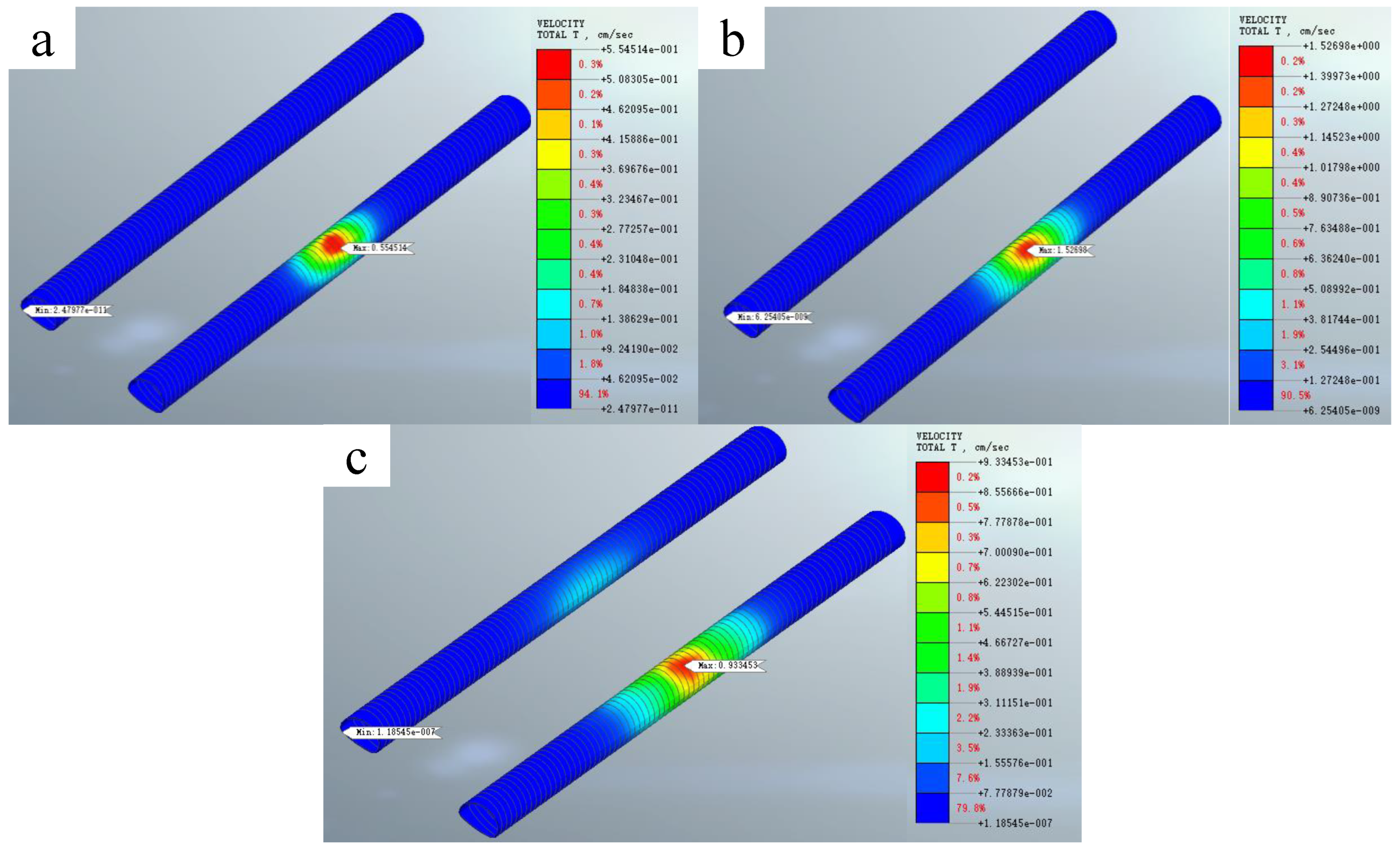
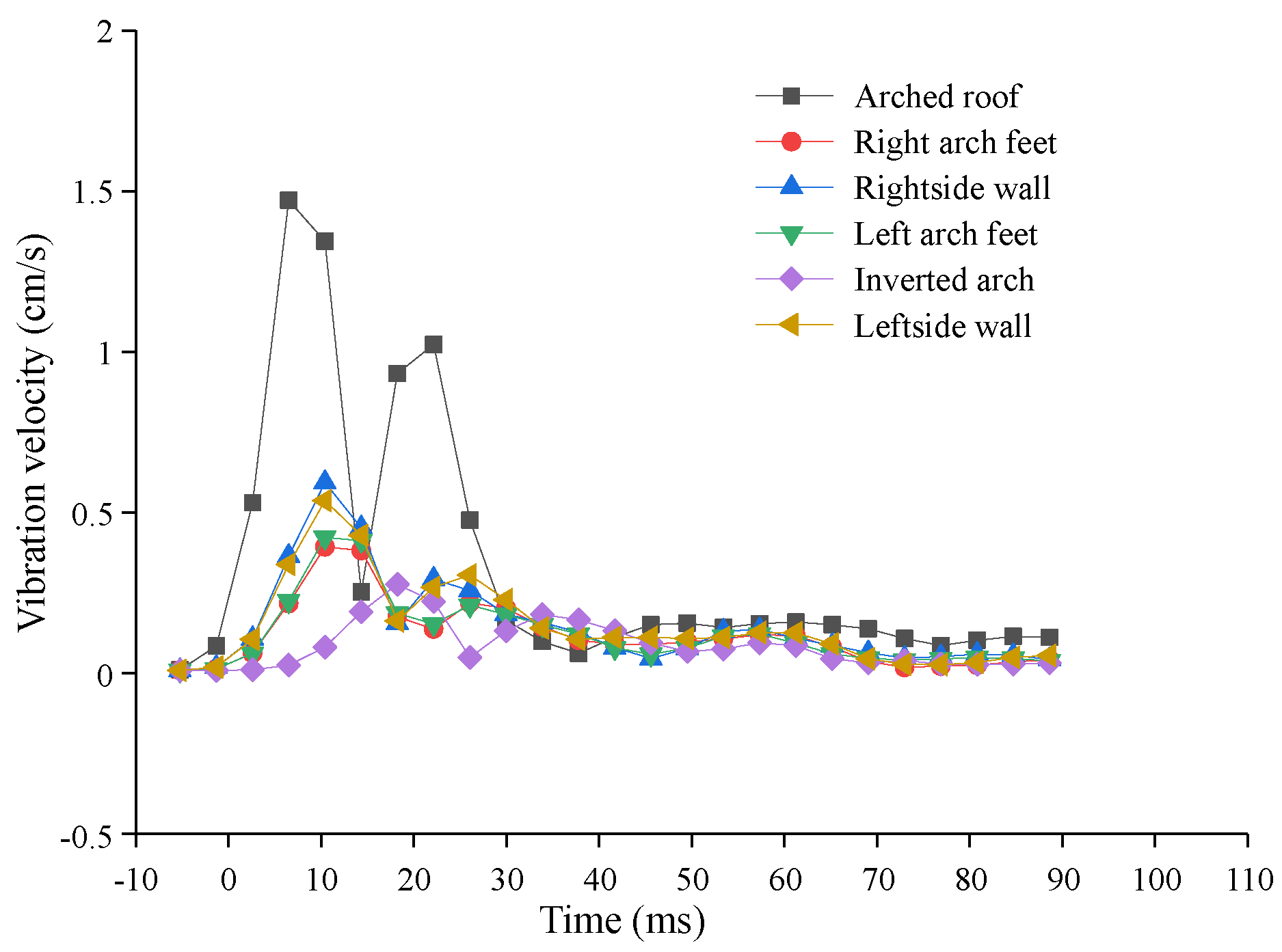
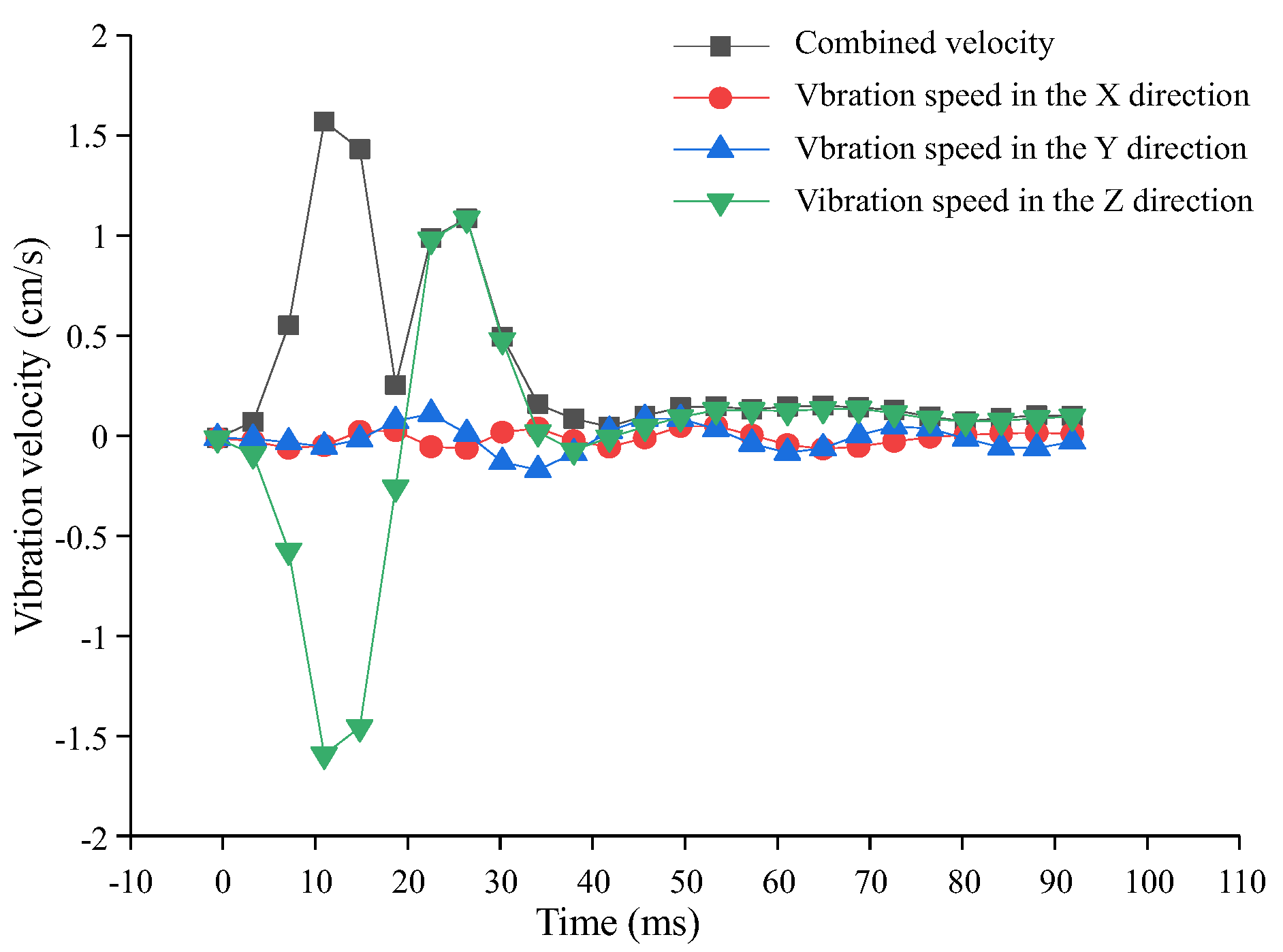
| Surrounding Rock Grade | Density (g/cm3) | Deformation Modulus (GPa) | Poisson Ratio | Elastic Resistance Coefficient (MPa/m) | Friction Angle (°) | Cohesive (MPa) | Calculating Friction Angle (°) |
|---|---|---|---|---|---|---|---|
| III | 2.75 | 18 | 0.28 | 800 | 45 | 0.8 | 65 |
| IV | 2.50 | 5 | 0.35 | 400 | 35 | 0.4 | 55 |
| Unit Weight (kN/m3) | Friction Angle (°) | Rock Consolidating Coefficient | Excavate Equivalent Diameter (m) | Excavation Height |
|---|---|---|---|---|
| 25 | 35 | 2.5 | 6.5 | 9.63 |
| Supporting Materials | Unit Weight (kN/m3) | Deformation Modulus (GPa) | Poisson Ratio |
|---|---|---|---|
| C20 Concrete (initial support) | 24 | 25.5 | 0.2 |
| C25 Concrete (secondary lining of highway tunnel) | 24 | 28 | 0.2 |
| C35 Reinforced concrete (secondary lining of railway tunnel) | 25 | 31.5 | 0.2 |
| Supporting Materials | Unit Weight (kN/m3) | Deformation Modulus (GPa) | Poisson Ratio |
|---|---|---|---|
| C20 Concrete (initial support) | 24 | 25.5 | 0.2 |
| C25 Concrete (secondary lining of highway tunnel) | 24 | 28 | 0.2 |
| C35 Reinforced concrete (secondary lining of railway tunnel) | 25 | 31.5 | 0.2 |
Disclaimer/Publisher’s Note: The statements, opinions and data contained in all publications are solely those of the individual author(s) and contributor(s) and not of MDPI and/or the editor(s). MDPI and/or the editor(s) disclaim responsibility for any injury to people or property resulting from any ideas, methods, instructions or products referred to in the content. |
© 2023 by the authors. Licensee MDPI, Basel, Switzerland. This article is an open access article distributed under the terms and conditions of the Creative Commons Attribution (CC BY) license (https://creativecommons.org/licenses/by/4.0/).
Share and Cite
Xianyao, D.; Guobin, W.; Ming, Y.; Yongquan, Z. Safety Evaluation of Crossing Tunnel Engineering: A Case Study. Appl. Sci. 2023, 13, 9459. https://doi.org/10.3390/app13169459
Xianyao D, Guobin W, Ming Y, Yongquan Z. Safety Evaluation of Crossing Tunnel Engineering: A Case Study. Applied Sciences. 2023; 13(16):9459. https://doi.org/10.3390/app13169459
Chicago/Turabian StyleXianyao, Dai, Wang Guobin, Ye Ming, and Zhang Yongquan. 2023. "Safety Evaluation of Crossing Tunnel Engineering: A Case Study" Applied Sciences 13, no. 16: 9459. https://doi.org/10.3390/app13169459
APA StyleXianyao, D., Guobin, W., Ming, Y., & Yongquan, Z. (2023). Safety Evaluation of Crossing Tunnel Engineering: A Case Study. Applied Sciences, 13(16), 9459. https://doi.org/10.3390/app13169459





